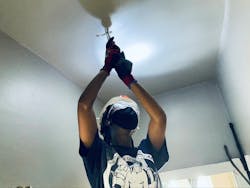The Apprentice’s Guide to NEC Art. 382
As you begin your quest to master navigating the National Electrical Code (NEC), you will uncover new and different wiring methods, materials, and interesting installation guidelines that will broaden your knowledge base. Learning about these materials will prepare you for just about any situation on the job, but remember to check with your local inspector or boss first. I didn’t know this wiring method existed until I became a licensed exam prep instructor. In fact, I haven’t used this wiring method in the field, nor have I seen it used on a job site.
If you dig deep enough into the wiring methods within Chapter 3 of the NEC, you’ll find this obscure but handy article for “Nonmetallic Extensions.” Article 382 covers the use, installation, and construction specifications for a highly “debatable” option for residential and commercial electricians. I expect to see some interesting comments on this option for wiring. Please post your thoughts and feedback at the bottom of this article in the comment section.
Concealable nonmetallic extensions are a multi-layer, thin, “flat” cable that uses copper conductors equivalent to 14 AWG or 12 AWG with a center ungrounded conductor enclosed by a sectioned “grounded” conductor and an overall sectioned “grounding” conductor.
Uses permitted — Sec. 382.10
NM extensions can be installed from an existing outlet on a 15A or 20A branch circuit [Sec. 382.10 (A)] and from a non–grounding-type receptacle, but the installation shall comply with Sec. 250.130(C), 406.4(D)(2)(b), or 406.4(D)(2)(c). It can be installed or “run” exposed and concealed in “dry” locations. Where identified for use, it can be mounted directly on the surface of walls or ceilings of residences and offices, if the building does not exceed three floors above grade.
Uses not permitted — Sec. 382.12
NM extensions cannot be used or “run” in unfinished basements, attics, or roof spaces — or where the voltage between conductors exceeds 150V and 300V for aerial cable. It cannot be subject to corrosive vapors, run through a floor or partition, or outside the room in which it originates.
It can be exposed or concealed — Sec. 382.15
One or more NM extensions shall be permitted to be run in any direction from an existing outlet, but not “on the floor” or within 2 in. from the floor. Here’s where it gets interesting; where identified for use, NM extensions shall be permitted to be concealed with tile, paint, plaster, texture, wallpaper, wall paneling, concealing compound or other similar materials. However, they must be installed in accordance with Sec. 382.15(A).
Let’s take a look at an example of a master electrician test question using this wiring method.
A listed assembly of two, three, or four insulated circuit conductors within a nonmetallic jacket, an extruded thermoplastic covering, or a sealed nonmetallic covering that can be mounted directly on the surface of walls and ceilings is the definition for:
A. Flat conductor cable
B. Flat cable assemblies
C. Nonmetallic sheath cable
D. Concealable nonmetallic extension
The best approach to answering this question is to use the process of elimination; cross reference each choice until you find your answer. Most test takers get this question wrong on the exam for the following reasons:
- They just take a wild guess because they are “unfamiliar” with this wiring method.
- They answer in haste without double checking every detail of what they are reading.
Answering this question takes time and requires patience. It’s very time consuming, so this isn’t something you should attempt to answer at the beginning of an exam. Each answer choice must be researched in the index or table of contents. The index will direct you to each specific Article. Within each Article is a section for “definitions,” “uses permitted,” and “not permitted.”
Sometimes, it can be difficult to distinguish which information is important. Just take your time, and read the details. Most exams are designed to check your reading comprehension and Code book navigation skills. If you act in haste, they will anticipate your mistake with answers that may trick you if you’re going too fast. So slow down, and read the details.
The correct answer is “D.” Most test takers select C out of haste.
Follow my column for more practical how-to articles and tips for applying electric basics concepts in the field. Past columns include Everyday Instructions for Electricians, The Apprentices Guide to Special Equipment, The Apprentice’s Intro Guide to Motors, The Apprentice’s Guide to Service Entrance Cable, The Apprentice’s Guide to Service Feeder Calculations, The Apprentice’s Guide to NEC Art. 550, and The Apprentice’s Guide to NEC Chapter 2. For more information on why a structured approach is so important to navigating the NEC and how to put its requirements into practice in real-world settings, read “The NEC for Newbies.”
Harold De Loach, a master electrician and electrical trainer/instructor, is the founder of The Academy of Industrial Arts (www.taia-school.com) in Philadelphia. With more than 30 years of experience in the field, he writes regular exclusive content for the E-Train and can be reached at [email protected].
About the Author
Harold De Loach
De Loach is the Director of Education and Training for the Leaders of Electrical License Preparation courses for Philadelphia and The Lehigh Valley (www.necprepclass.com). He is the founder and Director of The Academy of Industrial Arts L.L.C. (www.taia-school.com), a customized electrician training program that provides entry-level electrician training courses, electrical safety classes and customized electrical construction courses. He is trained by the National Center for Construction Education and Research (NCCER). He is a member of The National Society of Collegiate Scholars, the Independent Association of Electrical Inspectors, the Electrical Association of Philadelphia, and the Better Business Bureau.
His level of knowledge affords him to teach entry, intermediate, and master level electricians. Armed with more than 20 years of experience in the electrical, general construction, and real estate development industry, he offers his students and clients several unique skill sets. He has worked as the Head Craft Instructor and Assistant Director of Education at the Apprenticeship Training Center (affectionately known as The ABC School) in Harleysville Pennsylvania for Associated Builders and Contractors (The South-Eastern Pa. Chapter). Prior to Joining ABC, he directed a work-readiness (Re-Entry) Construction Technology program within The Philadelphia Prison System and as an Electrical Technician Program instructor at Kaplan Career Institute (Formerly Thompson institute) in Center City Philadelphia and Franklin Mills. He is available for consultation, private tutoring, speaking engagements, or strategic partnerships that can bolster the number of new electricians entering the industry.

